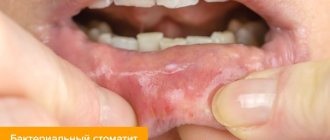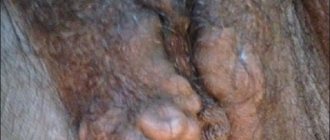Syphilis is characterized by the appearance of ulcers
Syphilis is characterized by the appearance of ulcers in the first period of the disease.
The sores are called chancre. They are characterized by compaction at the base, lack of pain, and enlarged inguinal lymph nodes.
A more detailed description can be found in the corresponding article.
Genital herpes is a chronic, long-lasting viral infection, the causative agent of which is the genital herpes virus (herpes type 2).
The rashes are localized in the area of the head and foreskin in men and the labia in women.
The rashes are represented by small painful ulcers located on the inflamed skin or mucous membrane.
There may be enlargement of the inguinal lymph nodes.
The disease is prone to recurrence if left untreated.
Diagnosis is helped by testing blood and scrapings from ulcers for genital herpes.
Genital candidiasis is a fungal infection of the genitourinary organs of men and women.
Characterized by redness of the skin and mucous membranes and the formation of a cheesy coating.
If the plaque is separated from the inflamed surface, superficial ulcers are found on it, which can be slightly painful.
Diagnosis is helped by the detection of candida fungi in the results of PCR and culture for candida.
Ulcers due to inflammation of the genitourinary organs from STDs
Even small and unnoticeable discharge can cause the formation of ulcers on the head of the penis and labia.
This occurs due to the destructive effect of pus on the mucous membranes and the introduction of STD pathogens there.
Ulcers in the genital area are described in many sources with gonorrhea, trichomoniasis, chlamydia and other sexually transmitted infections, when inflammation may develop.
Streptococcal infection in the genital area
Skin infection caused by streptococcus. It most often develops in children and young women with thin, sensitive skin.
However, given the characteristics of the skin of the groin area, which is also sensitive, thin, and moist, conditions may be created for it to be damaged by these bacteria.
Symptoms of streptoderma in the groin area include the appearance of flaccid blisters on red skin.
Inside the bladder is serous fluid or pus.
When the blisters open, ulcers with a diameter of up to 1 cm are formed.
The bottom of the ulcer may be covered with a purulent crust.
The ulcer is surrounded by a peeling covering of blisters.
Atypical forms of herpes
The symptoms are most often no different from genital herpes, but can be caused by the herpes labialis virus, herpes zoster virus, or the varicella-zoster herpes virus.
That is why, when collecting PCR material from ulcers, they always check for these types of herpes.
Traumatic ulcers in the genital area
Most often they appear in the coming days or even hours after sexual intercourse.
They represent a rupture of the skin due to mechanical tension.
Characterized by an oval shape and rapid healing from cold lotions with chamomile or saline.
Allergic lesions of the genital organs
In rare cases, allergies may cause large blisters to form on the skin.
When they open, ulcers form.
The disease is called eczema.
Characterized by damage to other areas of the skin, itching, and allergic blood reactions.
Diabetes
May be accompanied by redness and ulceration of the skin, including the genitals
Diagnosis consists of checking the level of glycated hemoglobin and sugar.
Ulcers on the penis with chancroid
Soft chancroid, or chancroid, is a sexually transmitted infection.
It is not very common in the Russian Federation.
This disease is endemic to hot countries, mainly in Africa and South America.
However, with the development of tourism, it is impossible to completely exclude the possibility of its occurrence.
The pathogen enters the body mainly during sexual intercourse.
The introduction of bacteria occurs when there are microtraumas on the skin of the genital organ.
Another portal of entry is the mucous membranes of the genitals.
Incubation of the pathogen lasts from 4 days to a week.
If the immune system is weakened, it can be reduced to a day.
If the body's resistance is strong, it will grow up to 2 weeks.
The first symptom is the formation of a red spot on the penis.
It is surrounded by edematous tissue.
Next, an abscess forms at the site of the spot.
It is accompanied by severe pain.
Sometimes several small chancroids form, they look like pustular rashes.
It is not difficult to distinguish soft chancre from hard chancre.
Primary syphiloma, unlike chancroid, does not cause physical discomfort to the patient.
Chancroid, in addition to being painful, differs from hard chancroid in appearance.
In the ulcer stage, its bottom is red.
It is accompanied by profuse purulent and bloody discharge.
A preliminary diagnosis of chancroid is made based on the following criteria:
- absence of symptoms of primary syphilis;
- negative treponemal tests;
- negative test result for herpes viruses;
- suppuration and soreness of regional lymph nodes;
- appearance of the resulting ulcer.
These symptoms are a sufficient reason for making a diagnosis.
For final confirmation, the patient is tested for the causative agent of chancroid.
Important!
With simultaneous infection by the causative agent of chancroid and Treponema pallidum, a mixed chancre is formed.
Its clinical picture is more similar to manifestations of chancroid.
With syphilis, there is a period of “serological window”.
Therefore, doctors, even when making a diagnosis, remain wary of syphilis.
Patients diagnosed with chancroid are monitored for six months.
During this period they undergo tests.
In case of infection with Treponema pallidum, they will help identify syphilis.
Therapy for soft chancre is carried out with broad-spectrum antibacterial drugs.
Their list includes Sumamed, Erythromycin, Ceftriaxone and Ciprofloxacin.
The drugs are used both in the form of tablets and by injection.
The course of treatment ranges from 1 day to a week.
Cancers
Such manifestations of cancer are typical for women during menopause against the background of atrophy of the vagina and vulva - kraurosis. Against the background of general dryness and thinning of the skin and mucous membranes of the genital organs, skin defects may appear in the form of painless ulcers and erosions that tend to grow deeper and wider. Most often we are talking about squamous cell skin cancer, less often – about other forms of oncology. Unfortunately, squamous cell carcinoma at the ulcer stage is an already advanced process that is not subject to radical treatment.
Lichen sclerosus - ulcers on scars
With a chronic disease such as lichen sclerosus (curarosis), the head of the penis is affected.
Timely diagnosis is very important.
This disease is considered a precancerous condition.
The exact cause of the disease has not been identified to date.
Predisposing circumstances are considered:
- family history of curarosis;
- autoimmune diseases;
- genitourinary infections and STDs;
- radiation sickness;
- hormonal disorders, pathologies of the endocrine system;
- injuries in the area of the glans penis.
The insidiousness of the disease is that for a long time lichen sclerosus can occur hidden.
Its first pronounced manifestations are similar to ulcers on the penis.
Initially, spots and papules are formed, whitish in color and with clear edges.
Then the rashes become concave, with a small depression appearing in their center.
Sometimes keratinized crusts form on the surface of the lichen rash.
Subsequently, the skin of the head of the penis dries out and loses elasticity.
Therefore, there is a risk of severe complications:
- phimosis;
- narrowing of the urethra;
- formation of cracks on the penis.
Initially, the disease affects only the foreskin, then the head, and even later the urethral opening.
After all the signs appear, the risk of the rash becoming malignant increases sharply.
Therefore, patients with curarosis must undergo regular examinations by an oncologist.
To exclude a cancerous condition, affected tissues are taken for analysis using a biopsy.
Ulcers on the penis with chancriform pyoderma
Chancriform pyoderma is very rare.
This is a severe chronic disease with pronounced inflammatory and purulent manifestations.
External resemblance to hard and soft chancre can make diagnosis difficult.
The exact causes of the disease are not fully known.
Infectious agents are pathogenic and conditionally pathogenic microorganisms.
Most often these are streptococci.
Pathogens enter the body through microtraumas.
Infection with blood flow from other inflammatory foci is less common.
Diabetes mellitus and decreased immunity are considered risk factors.
They predispose to the development of chancriform pyoderma.
Why the infection occurs in this particular form is unknown to modern science.
The localization of the inflammatory and ulcerative process mainly occurs on the head of the penis.
The first sign of the disease is a bubble up to 2 centimeters in size.
It quickly breaks through and an ulcer forms in its place.
The difficulty of differentiating it from chancre is the absence of pain and itching.
But with chancriform pyoderma, regional lymphadenitis occurs with severe pain.
With syphilis, the lymph nodes are only enlarged, and upon palpation they do not cause discomfort to the patient.
An increase in body temperature with chancriform pyoderma is rare.
This is a dangerous symptom.
It may indicate generalization of infection, even sepsis.
When making an accurate diagnosis, doctors first of all rule out infection of the patient with syphilis.
For this purpose, both serological tests and treponemal tests are used.
Microbiological examination reveals a large number of staphylococci and streptococci.
Treatment is carried out using antibacterial drugs.
It is recommended to first test the sensitivity of pathogens to various antibiotics.
This is necessary to ensure the success of the therapy.
In addition to antibacterial therapy, treatment is carried out to increase immunity.
An additional way to speed up the healing of ulcers is local physiotherapy.
Review of drugs for the treatment of intimate wounds
For bacterial, viral and fungal diseases, both partners are treated. In order to avoid negative consequences and complications during therapy, it is necessary to abstain from sexual intercourse and maintain hygiene of intimate organs.
Treatment is complex and includes taking local medications: ointments, gels, suppositories.
| Pharmacological group | Features of the drugs, for the treatment of which wounds they are used | Examples of drugs |
| Antibacterial | Treatment of intimate wounds due to infections caused by bacteria. | Levomekol, Baneocin, Tetracycline ointment |
| Antimycotic | Therapy for thrush, medications for fungi of the Candida variety | Fluconazole, Clotrimazole |
| Antihistamines | Treatment of mucous membranes in the intimate area resulting from allergies. | Suprastin, Zodak, Fenistil |
| Antiviral | Treatment of wounds due to viral diseases (herpes) | Acyclovir, Viferon, Interferon |
| Nonsteroidal anti-inflammatory drugs | Reducing pain from itching, burning, and discomfort. The products temporarily relieve pain, swelling and inflammation. | Diclofenac, Ibuprofen |
Review of healing ointments:
- Solcoseryl is a medicine based on the blood of calves obtained by hemodialysis. The healing process of damage in intimate areas is accelerated by stimulating collagen production and improving glucose transport into metabolically depleted cells and tissues. The medicine is available in the form of a gel, ointment and solution for injection. The gel is used for rapid granulation and release of purulent contents from the wound. The ointment is used when the damaged area dries out.
- Levomekol - effectively treats wounds on the head of the penis, and is also used after gynecological operations. The ointment is effective in the treatment of infected ulcers; it contains an antibiotic. Active components of the drug: methyluracil and chloramphenicol. The first ingredient improves cellular nutrition and accelerates skin regeneration, the second is active against gram-positive and gram-negative bacteria.
- Protact - cream will help with minor damage and cracks, relieves minor redness and irritation. A protective antimicrobial film is formed on the surface of the skin, providing the necessary hydration to intimate, delicate areas.
- Pantestin is a medicine based on the active components dexpanthenol and miramistin. When the gel comes into contact with the skin, it changes its chemical composition: dexpanthenol is converted into pantothenic acid. Wound healing is accelerated and skin regeneration is ensured. The drug acts locally and is not absorbed into the systemic circulation.
- Rescuer - the drug is effective for deep and superficial damage to intimate areas. Regenerating and antibacterial properties are provided, the medication helps with purulent wounds.
- Argosulfan is a complex drug that has antibacterial and analgesic effects. The hydrophilic base of the cream helps maintain an optimal level of moisture on damaged skin.
The ointments are easy to use and can be used at home. Directions for use: Apply a thin layer to the damaged surface.
The drugs have contraindications and age restrictions for use. During pregnancy and lactation, treatment is carried out after consultation with a doctor.
Ulcers on the penis with syphilitic ecthyma
Secondary syphilis can be severe.
One of them is syphilitic ecthyma.
It develops one and a half to two years from the onset of the disease.
With this course of syphilis, the formation of ulcers is observed.
Outwardly, they are similar to gumma ulcerations in tertiary syphilis.
Secondary syphilis with ecthyma is clinically severe.
The patient's temperature rises markedly and symptoms of general intoxication are observed.
The first symptom of syphilitic ecthyma is the appearance of red spots.
They cause severe pain.
Then the elements of ecthyma ulcerate, and in their place a pustule with purulent discharge is formed.
After drying, a crust forms on its surface.
There is a dark red infiltrative ridge around it.
The crust does not adhere tightly to the edges of the ulcer and is easily removed.
On the penis, syphilitic ecthyma develops relatively rarely.
Most often it affects the extremities, especially the legs.
Syphilis with the manifestation of syphilitic ecthyma is usually resistant to antibacterial therapy.
In addition, the presence of extensive ulcers contributes to the addition of a secondary infection.
This aggravates the patient's condition.
Genital irritant dermatitis - causes
Genital irritant contact dermatitis is an inflammation of the skin. It manifests itself as redness (genital rash) and mild swelling of the skin resulting from a nonspecific reaction to direct chemical injury. The agent, which acts as a strong irritant, causes damage to the epidermal skin cells and an inflammatory response, leading to redness, swelling and ulceration of the skin.
Chemicals that remove the lipid layer of the skin or damage the cell membrane cause irritation.
Common irritants:
- soap and detergents;
- hygiene products (for example, tampons, sanitary pads, wet wipes);
- baths, shower gel, oils, perfumes;
- toilet paper;
- condoms (latex);
- washing the genitals too often;
- wearing synthetic and colored underwear.
Ulcers on the penis with syphilitic rupee
Syphilitic rupee is considered a separate type of syphilitic ecthyma.
This form of the disease is considered extremely severe.
Syphilitic rupee develops within six months to 2-3 years from the onset of the disease.
The first manifestations of rupee are similar to ecthyma.
Most often they begin with the formation of boil-like elements.
But with a rupee, the ulcer continues to grow deeper into the tissue.
When the scab is removed, a deep and severely painful wound is revealed.
Purulent-bloody contents are released from it.
After the rupee heals, noticeable scars always remain on the skin.
Like ecthyma, rupee rarely affects the penis and usually forms on the skin of the torso.
Contagiousness of ulcers due to syphilis
Syphilis is a highly contagious disease.
Treponema pallidum easily penetrates the body and is difficult to treat.
If there are rashes, the maximum number of pathogens is present on their surface.
Many manifestations are extremely dangerous from an epidemic point of view.
These are chancre, syphilitic rash, rupee, ecthyma and ruptured gumma.
Contact with them can lead to infection even without sexual contact.
Therefore, family members and loved ones of a person with syphilis should follow safety rules.
Such a person must have strictly individual:
- dishes;
- cutlery;
- underwear and bed linen;
- towels;
- bath accessories.
Medical staff are at high risk of infection from syphilitic ulcers when working with patients.
Therefore, it is extremely important for the patient to promptly warn health workers about the presence of infection.
Intentionally infecting people with sexually transmitted diseases is a crime in Russia.
This entails criminal liability.
Ulcers on the penis due to donovanosis
Like chancroid, donovanosis is a relatively rare sexually transmitted infection for our country.
Its main manifestation is the formation of an ulcerative rash on the penis.
Donovanosis is predominantly transmitted during sexual contact.
The presence of microtraumas and abrasions on the skin of the penis increases the chance of infection.
The infection is rarely transmitted through household means.
The causative agent of donovanosis is unstable in the external environment.
Donovanosis can occur in several forms.
The ulcerative form is the most common of all.
It causes ulcers to form on the penis.
After healing, a scar may form in their place.
As the disease progresses, the ulcers spread to areas of skin adjacent to the genitals.
The verrucous form is more severe than the usual ulcerative form.
It causes large ulcers with bloody discharge.
Another possible form of the disease is eliphantiasis .
With it, elephantiasis develops, or hypertrophied enlargement of the penis.
The flowering form also manifests itself with characteristic ulcerative elements.
Unlike other forms of donovanosis, the discharge from such ulcers is purulent in nature.
Patients suffer from severe pain and itching in the area of the inflamed elements.
When a secondary infection occurs, the most severe form of donovanosis can develop – necrotic .
The discharge from ulcers is purulent and bloody in nature.
Such ulcers penetrate deep into the tissues.
This can lead to complete destruction of the genital organs.
By hematogenous and lymphogenous routes, the infection spreads throughout the body.
In this case, damage to other organs occurs, and sometimes sepsis develops.
Necrotizing donovanosis without adequate treatment can lead to death.
Like other ulcerative lesions of the penis, donovanosis is distinguished from syphilis and chancroid.
If tests for both of these infections are negative, a test for the causative agent of donovanosis is performed.
The presence of the pathogen is determined by bacteriological culture.
The patient may develop complications.
Therefore, it is better to conduct an examination of a person suspected of having donovanosis in a hospital setting.
Leading specialists in the treatment of bartholinitis in the Southern Federal District
Ermolaeva Elvira Kadirovna is a well-known and recognized specialist in the treatment of bartholinitis in the North Caucasus. She is a gynecologist, ultrasound doctor, physiotherapist-resortologist. Women who want to improve the aesthetics of the genital organs, reduce the size of the vagina and refresh intimate relationships from all regions of Russia and foreign countries turn to Elvira Kadirovna .
Ermolaev Oleg Yurievich Candidate of Medical Sciences, operating gynecologist with 25 years of successful experience in treating bartholinitis. Able to see relationships that elude others.
Shchepkin Petr Sergeevich Gynecologist, specialist in the treatment of bartholinitis and marsupalization of the Bartholin gland. Experienced ultrasound doctor.
About the doctors of the Clinic in detail...
| INTERNATIONAL RECOGNITION of the reputation and achievements of the Women's Health Resort Clinic in the development and implementation of effective and safe treatment methods and the quality of medical services provided is the AWARDING of the Women's Health Resort Clinic in Pyatigorsk with the SIQS International QUALITY CERTIFICATE in the field of medicine and healthcare. International Socratic Committee, Oxford, UK and Swiss Institute for Quality Standards, Zurich, SWITZERLAND. |
We work seven days a week and on holidays:
Monday - Friday from 8.00 to 20.00, Saturday, Sunday, holidays from 8.00 to 17.00.
Treatment of bartholinitis, opening of the Bartholin gland and marsupalization of the Bartholin gland by appointment by multi-line phone 8 (800) 500-52-74 (free call within Russia), or +7 (for foreign calls).
The cost of opening the Bartholin gland WITHOUT PAIN is 4250 rubles.
| ONLINE information about the treatment of bartholinitis can be found at: [email protected] REGISTER ONLINE for the treatment of bartholinitis here. REGISTER online for marsupalization of the Bartholin gland here. Buy coursework by phone +7 (928) 022-05-32 or here. |
Make an appointment with a gynecologist
If there is severe bursting and throbbing pain in the labia majora, high body temperature (more than 38°C) and/or poor health, we accept without a prior appointment outside the queue.
Treatment of bartholinitis with the help of phytotherapeutic and physiotherapeutic agents allows one to achieve a complete cure and prevent the transition to a chronic form and the formation of an abscess (pseudo-abcess) and a cyst of the Bartholin gland.
With respect for the religion and different habits of our Patients, we achieve high efficiency and comfort of treatment.
We are at your FULL DISPOSAL if you have any doubts or wishes.
- Reviews about treatment in our Clinic
- About the Clinic
- Why choose us
- Clinic team
After spontaneous opening of a pseudoabscess of the Bartholin gland, the outpouring of purulent contents, as a rule, does not occur completely.
The pyogenic (pyogenic) capsule is preserved. And after gluing and scarring of the fistula tract, the process begins to mature again.
Spontaneous opening of a Bartholin gland pseudoabscess leads to the formation of a rough scar.
The only consolation for this is the thought of limited access for contemplation...
The cost of opening the Bartholin gland WITHOUT PAIN is 4250 rubles.
Make an appointment with a gynecologist
Ulcers after removal of condylomas and warts
Normally, after excision of pathological tissue growths, ulcerative lesions do not develop.
The formation of ulcers, especially with purulent or bloody discharge, is a sign of infection.
This may happen for the following reasons:
- weakened immune system;
- the presence of infectious foci in the body;
- exacerbation of severe chronic diseases;
- insufficient postoperative wound care;
- diabetes mellitus of both types.
Treatment for such conditions depends on the type of infection and its severity.
In some cases, you can limit yourself to local antiseptics and attention to wound care.
In severe cases, antibiotics, excision of the edges of the ulcer, and hospitalization may be necessary.
In any case, such a complication requires mandatory consultation with a doctor.
Diagnostics
To identify the cause of the formation of ulcers on the genitals, a woman undergoes:
- Survey
- Examination on a gynecological chair
- Laboratory testing of blood and urine
- Smear to determine vaginal microflora
- Ultrasound of the uterus, appendages
- Determination of blood glucose levels
- Analysis for the presence of tumor markers in the body
- PCR diagnostics
If the development of a precancerous condition is suspected, the woman is prescribed a biopsy of the ulceration particle and a histological analysis of the material taken. The range of necessary studies depends on the individual characteristics of the clinical case. There is no single diagnostic program that would suit absolutely all patients.
Which ulcers are not contagious?
Only ulcers due to non-communicable diseases are guaranteed not to threaten others.
This is the only category of ulcerations that are not dangerous to other people.
Such diseases include allergic reactions, dermatitis and dermatoses, injuries, and autoimmune diseases.
They are not contagious either through household or sexual contact.
It is important to remember that ulcerative elements can always be accompanied by a secondary infection.
Ulcers on the penis require the mandatory use of condoms for any type of sexual contact.
Therapy
Treatment for ulcers depends on the disease and pathogen. For viral diseases, it is necessary to take a course of antiviral drugs. This could be Acyclovir or Zovirax.
If the disease is caused by bacteria, then only antibiotics will help. In case of serious pathologies, they are injected intramuscularly or intravenously. Most often, doctors prescribe penicillin or cephalosporin antibiotics. If you are allergic to them, then drugs of the macrolide or tetracycline group will help.
In case of allergic reactions, it is necessary to protect yourself from exposure to allergens and take antihistamines. These include Suprastin, Zodak, Zirtek.
It is also recommended to strengthen the immune system with a complex of vitamins and immunomodulators. It is necessary to normalize your diet and adhere to the rules of a healthy lifestyle.
The dosage and duration of taking medications is prescribed by the attending physician.
Which doctor treats ulcers on the penis?
Treatment for penile ulcers depends on the causes of their occurrence.
However, most often they are caused by sexually transmitted infections and specific skin diseases.
Therefore, first of all, the patient should contact a dermatovenerologist.
The doctor can redirect the patient to a surgeon or allergist-immunologist.
This occurs if the lesion is traumatic or allergic in nature.
Generalized infections may require referral of the patient to hospitalization.
The patient is admitted to the infectious diseases or surgical department.
It depends on the cause of the ulcers.
A dermatovenerologist deals primarily with skin and venereal diseases.
Other specialists may be involved to assist in treatment according to their profile.
You can contact a dermatovenerologist at a state clinic under the compulsory medical insurance policy.
In addition, you can come to a private medical institution.
The advantage of public medicine is the absence of fees for consultations, tests and treatment.
Paid clinics provide faster assistance and the ability to choose your visit time.
Commercial medical institutions cooperate with private laboratories.
Therefore, the tests will be ready quickly.
In some cases, this can significantly affect the prognosis of the disease.
Complications of ulcers on the penis
The severe consequences of penile ulcers can depend on both the ulceration and the infection that caused it.
The most common negative consequences are:
- scar formation;
- destruction of penile tissue by deep ulcers and necrosis;
- generalization of local infection;
- phimosis;
- balanitis and balanoposthitis.
Most complications develop against the background of insufficient or inadequate therapy.
Only attention to the disease and timely visits to the doctor will help to avoid them.
It is prohibited to change the course of treatment without prior consultation or special instructions.
This is especially true for antibiotics.
If you stop taking them prematurely, resistant strains of microorganisms are formed.
This then leads to complications of treatment and ineffectiveness of even the most modern antibiotics.
Self-medication is another unacceptable mistake when developing ulcers on the penis.
Incorrect treatment or lack thereof can lead to infection of sexual partners and loved ones.
Prevention
To prevent the development of diseases that are accompanied by the appearance of ulcers on the labia, it is necessary:
- Carry out intimate hygiene thoroughly and promptly using hypoallergenic products
- Avoid unprotected intimate relationships with unfamiliar partners
- Avoid hypothermia
- Avoid excessive use of pads (especially scented ones)
- Maintain intestinal microflora at normal levels
- Avoid wearing overly tight underwear
Additional preventive measures are to abandon the uncontrolled use of antibiotics, avoid stress, and undergo seasonal vitamin therapy. With a high probability of developing diseases that manifest themselves as erosions on the genitals, it is possible to avoid.
Ulcers on the labia are one of the basic signs of sexually transmitted diseases. In more rare cases, the formation of a defect relates to manifestations of allergies, skin or other disorders. Disorders that lead to the formation of erosions on the genitals can be easily eliminated. To normalize well-being, it is necessary to undergo comprehensive treatment. Before visiting a doctor, it is not recommended to take medications or use various methods to treat the defect that has appeared.
Treatment of ulcers: effective antibiotics and when they are not needed
For bacterial infections, antibacterial drugs are the main method of treating the disease.
Therapy begins with broad-spectrum antibiotics.
This happens when its immediate onset is required and there is no time to determine the type of pathogen.
The doctor may replace the drug with one that is more relevant for a specific disease.
This depends on an accurate diagnosis and antibacterial tests.
Not all infections can be treated with antibiotics.
Such drugs are powerless for:
- non-infectious skin lesions;
- viral infections, such as herpes;
- fungal diseases.
For such diseases, specific treatment is necessary.
Viral infections require antiviral drugs and immune stimulation.
Fungal diseases are treated with antifungal agents.
Non-infectious lesions are treated depending on the exact cause of the disease.
Any means can be used both internally and externally.
For this purpose, ointments, creams, baths and lotions are used.
Most often, local treatment is auxiliary to general therapy.
Scabies
Strictly speaking, scabies is not a sexually transmitted infection. This parasitic disease, caused by the scabies mite, occurs through close household contact with an infected person.
Scabies
Skin lesions can occur anywhere, including on the genitals. The scabies mite penetrates under the stratum corneum of the skin, periodically emerging to the surface. Such movements of the parasite cause extremely specific symptoms - night itching and typical tick burrows.









